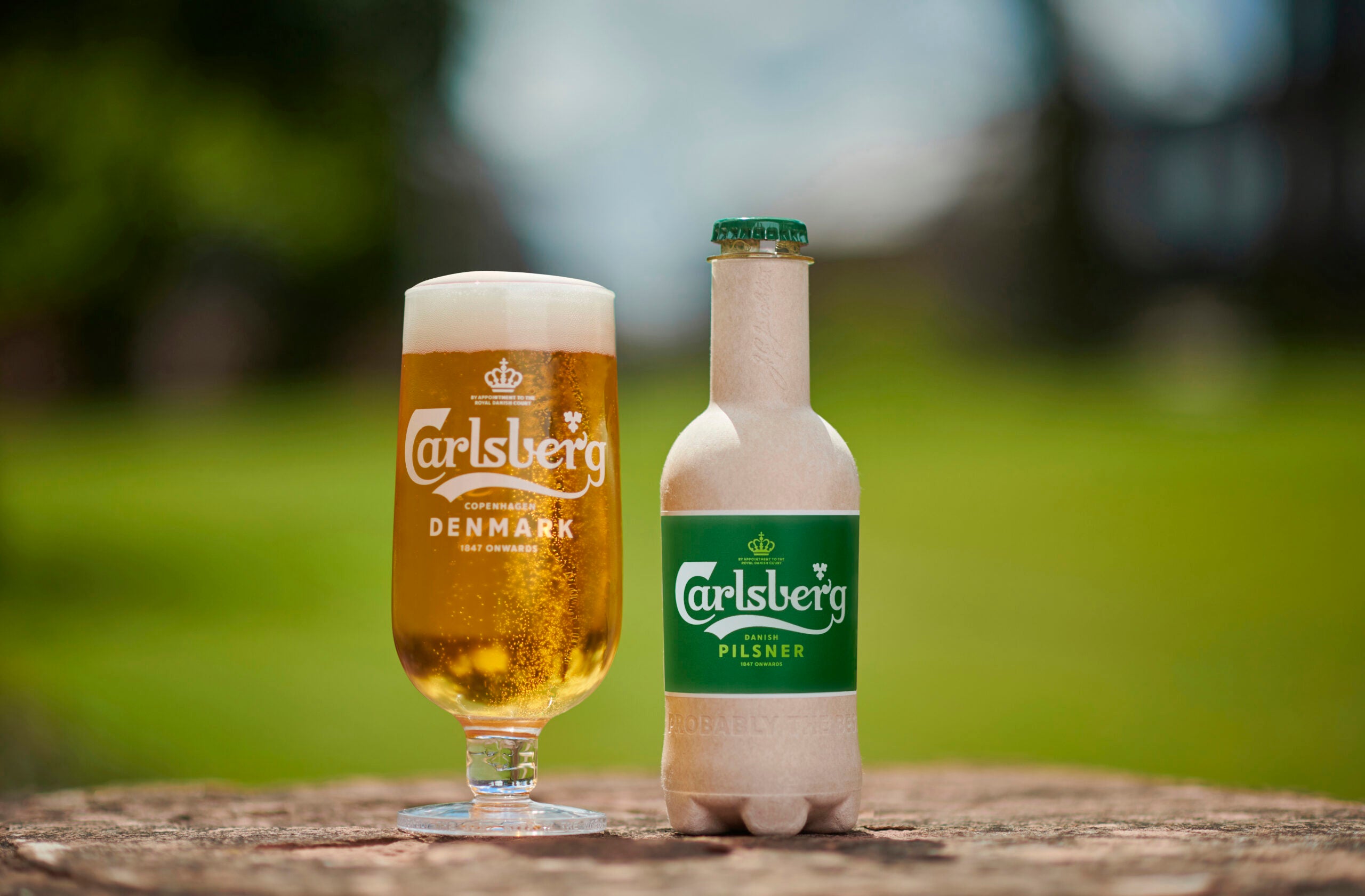
Carlsberg moves closer to reaching its ESG targets and providing sustainable package solutions for the bottling industry with the creation of its Generation 2.0 Fibre Bottle.
In June, the global beer company launched a trial across eight European countries of a new fully recyclable bottle as a low-carbon packaging alternative to traditional bottles and cans. Carlsberg says the Generation 2.0 Fibre Bottle already performs better than the single-use glass bottle in the product’s life cycle assessment. The beer company is looking to build on this innovation with the Generation 3.0 design by aiming for 80% less emissions than current single-use glass bottles.
Packaging Gateway’s Ryan Ellington interviewed Carlsberg’s group sustainability director Simon Boas Hoffmeyer, who is responsible for the Carlsberg Group’s ESG and sustainability activities, including the development and implementation of its ESG programme, Together Towards ZERO.
What are the new fibre bottles made from?
The outer shell of the bottle, produced by the packaging company Paboco, consists of sustainably-sourced wood fibre and it is bio-based. The inner plant-based PEF polymer lining is the most significant milestone for the Fibre Bottle, which has been developed by Carlsberg’s partner Avantium.
PEF is made entirely from natural raw materials and functions as a highly effective barrier between the beer and the fibre outer shell. The cap is aluminium which is currently needed to ensure the quality of the product, and together the bottle and cap are fully recyclable.
Is any plastic used to create the bottle?
The bottle has an inner lining of a plant-based polymer, polyethylenefuranoate, (PEF), which is compatible with conventional plastic recycling systems while also being degradable in case it is discarded in nature. It is necessary to add a barrier between the liquid and the bottle´s paper-like outer shell, keeping the beer equally fresh and great-tasting for up to six months.
PEF is a revolutionary alternative polymer – not only is it made entirely from renewable raw materials, but it can retain carbon dioxide better than conventional PET plastic, so both the environment and the beer benefit.
How did you choose the material for the new bottle?
We investigated various options when deciding to develop a bio-based and degradable bottle – and in the end we decided that fibres offered a very natural look and feel, with the added benefit of being naturally and responsibly sourced.
For the inner barrier, PEF was chosen due to its sustainability credentials i.e. biobased, degradable and recyclable, as well as its technical properties which met our strict quality standards.
What will the new fibre alternative bottles replace?
The new bottles won’t be replacing anything. When able to be produced at scale, it will expand Carlsberg consumers’ choice and complement, rather than replace, existing packaging like glass bottles and cans.
Does the new bottle affect the beer’s shelf life?
Together, this particular brew and bottle have a shelf-life of six months, and the product is best stored chilled for an optimal consumer experience of the same beer quality, freshness and taste.
Our bottles and cans have a nine to 12 months shelf life, and the reason for the shorter shelf life is that while the brew itself adheres to our high-quality standards, the bottles were produced at a smaller pilot-scale and had to go through a different filling process versus our regular bottles.
Given this difference in the filling step of the production process, we have brought the best-before-date forward and recommend cold storage.
What are the benefits of using an alternative material instead of glass or plastics?
We believe all our packaging can be made more sustainable – both existing packaging (like cans and glass bottles), and an innovation like the Fibre Bottle. As we develop the Fibre Bottle further, our aim is for it to achieve the same carbon footprint as our most comparable, best-performing off-trade packaging: the refillable glass bottle.
We have conducted a third-party-verified Lifecycle Assessment to understand how the Fibre Bottle compares on environmental performance and our opportunities to improve it further.
Generation 2.0 of the Fibre Bottle already performs better than the single-use glass bottle in the product ́s lifecycle assessment, and Carlsberg has even greater ambitions for the subsequent Generation 3.0 design.
Carlsberg’s vision, supported by current projections, is for the Fibre Bottle to achieve up to 80% less emissions than current single-use glass bottles. Thus, for every single-use glass bottle created, five Fibre Bottles could be created using the same carbon footprint. When the Fibre Bottle is commercialised at scale, it will expand Carlsberg consumers’ choice and complement, rather than replace, existing packaging like glass bottles and cans.
How do the production costs differ?
For the Generation 2.0 bottle, the costs are high due to the relatively small scale when compared to high-volume existing packaging. However, the aim is for the fibre bottle to have the same cost profile as a single-use glass bottle.
Should the industry step away from traditional bottling methods?
We believe consumers should have many sustainable packaging options, not just a few which is why we are developing innovative solutions like the Fibre Bottle and the Snap Pack.
What else can the industry do to ensure products are packaged sustainably?
We are constantly working to make all our packaging more sustainable, including making our materials lighter, increasing the amount of recycled content, supporting effective recycling infrastructure and investing in new materials. A great example of this is our new conditional off-take agreement with Avantium to use PEF as a material for our packaging applications.
PEF is made entirely from natural raw materials, is compatible with plastic recycling systems, and can degrade into nature should it end up outside national recycling systems. Beyond its sustainable packaging benefits, PEF functions as a highly effective barrier between the beer and the fibre outer shell, protecting the taste and fizziness of the beer better than conventional fossil-fuel-based PET plastic.




